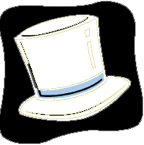Six Thinking Hats: The White Hat
The following includes excerpts regarding the White Hat from the book Six Thinking Hats by Edward De Bono
Introduction
The white hat is about information. When the white hat is in use, everyone focuses directly and exclusively on information.
- What information do we have?
- What information do we need?
- What information is missing?
- What questions do we need to ask?
- How are we going to get the information we need?
White hat information includes:
- facts and figures that can be verified (hard data)
- opinions and feelings expressed by others (soft information)
If two pieces of information disagree, there is no argument! Both pieces are put down in parallel.
The white hat can be used at the beginning (background) and toward the end (assessment) of a session.
The white hat is neutral; it is not for generating ideas. However, it can be used to report on ideas that have been suggested.
Information that is needed or missing is part of the white hat. It defines the questions that should be asked and lays out the means for obtaining the needed information.
Facts & Figures
- Can you role-play being a computer?
- Just give the facts in a neutral and objective manner.
- Never mind the interpretation: just the facts please.
- What are the facts in this matter?
Facts are often used for some purpose rather than presented as facts. They are used to support an argument rather than objectively review the situation.
White hat thinking advocates mapping the situation first and then choosing the route. This is process used, rather than providing a conclusion and bringing in facts to support the conclusion.
The framing of suitable focusing questions is part of the normal process of asking for information. Some occupations use questions to support their line of argument or to destroy the line of argument of the other side.
White hat thinking becomes a discipline which encourages the thinker to separate quite clearly in his or her own mind what is fact and what is extrapolation or interpretation.
Whose Facts Is It?
- Is it a fact or a likelihood?
- Is it a fact or is it a belief?
- Are there any facts?
Much of what passes for fact is simply a comment made in good faith or is a matter of personal belief at the moment.
There is a two-tier system related to facts:
- Believed facts or checked facts
- Checked facts
Before you act upon a fact or make it the basis for a decision, you need to check it. Decide which of the believed facts is useful and relevant and then proceed to try and verify it.
Your opinion is never permissible under white hat thinking. You can report the actual opinion of someone else.
Japanese-Style Input
- Discussion, argument and consensus.
- If no one puts forward and idea, where do ideas come from?
- Make the map first.
The Japanese never acquired the Western habit of argument. At Western-style meetings the participants sit there with their points of view and in many cases the conclusion they wish to see agreed upon – marble sculpture: start with broad block and carve down to an end product.
A Western-style consensus meeting is less argumentative – clay sculpture: a core around which clay is placed and molded to give the final output.
Japanese meetings consist of participants coming without any preformed ideas in their heads. The purpose of the meeting is to listen. As white hat information is brought up the map gets more complete.
The Western notion is that ideas should be hammered into shape by argument.
The Japanese notion is that ideas emerge as seedlings and are then nurtured and allowed to grow into shape.
Facts, Truth and Philosophers
- How true is a fact?
- Of what value are the language games of philosophy?
- Absolute truths and “by and large.”
White hat thinking is concerned with usable information. So the “by and large” and “on the whole” idioms are perfectly acceptable.
The spectrum of likelihood might be expressed as follows:
Always true, Usually true, Generally true, By and large, More often than not, About half the time, Often, Sometimes true, Occasionally true, Been known to happen, Never true, Cannot be true.
The purpose of white hat thinking is to be practical. So we must be able to put forward all sorts of information. The key point is to frame it properly.
Who Puts on the Hat?
- Put on your own hat.
- Ask someone to put on the hat.
- Ask everyone to put on the white hat.
- Choose to answer with the hat on.
Most situations are covered with the above statements. What it amounts to is that you can ask, be asked, or choose.
The white hat thinking excludes such valuable things as hunch, intuition, judgment based on experience, feeling, impression and opinion.
Summaries & Conclusions
White hat thinking should be neutral and objective. It should not involve interpretations or opinions.
Focused questions should be used to obtain information or to fill in information gaps.
Two-tier system of information:
- Checked or proven facts (first class)
- Believed to be true but not fully checked (second class)
There is a spectrum of likelihood that can be thrown out under the white hat, provided the appropriate “frame” is used to indicate the likelihood.
The white hat thinker strives to be more neutral and more objective in the presentation of information.
